SV Darmstadt 98 are looking back at turbulent years over the last decade.
Under former German international Dirk Schuster, Darmstadt was promoted twice in a row, marching from 3. Liga into the Bundesliga within just two years.
While everyone thought their stay in the top flight would only last a year, Darmstadt managed to secure their spot in the Bundesliga for a second season.
However, after their successful season, they lost their manager and most of their players.
After their relegation in 2017, Darmstadt struggled a bit in the 2. Bundesliga but eventually established themselves as a team that constantly made appearances in the top three in the closing table of the season.
After another good year, Werder Bremen poached away then-Darmstadt coach Markus Anfang, which opened the door for Thorsten Lieberknecht to become the new manager at the “Bölle.”
Lieberknecht finished fourth in his first season and managed to get the team promoted to the Bundesliga again in his second season.
Still, after their first-season back-up, Darmstadt was relegated due to a lack of individual class and a couple of rough injuries.
Forming a team was a difficult task after an eventful summer with many departures and new signings.
Lieberknecht struggled, scoring only two goals in four games and losing three out of four league games.
The club decided to relieve the otherwise successful coach from his duties.
His replacement? Florian Kohfeldt.
The 42-year-old coach from Delmenhorst has become a bit of a meme in the German football community.
After many years as an assistant and academy coach at his hometown club, Werder Bremen, Kohfeldt became the head coach of Werder in 2017.
After two very good seasons for Werder, the club ultimately was completely overblown by bad decisions made by Kohfeldt, resulting in survival in the relegation play-off in 2020 and, finally, relegation in 2021, the two worst seasons in the club’s rich and long history.
Kohfeldt was relieved of his position just one game before Werder was relegated, but he did not take a long break.
Instead, he took on a job at VfL Wolfsburg, where he was fired within the same season.
Last season, Kohfeldt managed KAS Eupen, but with no success, the coach decided to step down to avoid another relegation.
With no success since 2019 and not acknowledging any fault in any situation, Kohfeldt became the poster boy for the new generation of unsuccessful coaches, like Michael Frontzeck was in the years before.
However, Kohfeldt managed to turn around Darmstadt instantly.
In the nine games under his reign, Darmstadt scored 15 points in eight league games and has only lost one game.
In this tactical analysis and team report, we will
analyzeFlorian Kohfeldt’s tactics for turning around SV Darmstadt 98’s season, which had spiralled out of control after just four matchdays.
Darmstadt Attacking Power
Looking at the bad start to Darmstadt’s season, one thing stands out: their attack.
Scoring just two goals in the opening four games of the season, Darmstadt never were set up for success.
Florian Kohfeldt’s coaching style managed to change the picture here quickly.
In nine games with him on the sideline, Darmstadt scored an impressive 27 goals, three per game, five goals on three different occasions, and never was held scoreless.
The last thing is interesting because when Kohfeldt was at Werder Bremen, his team held the record for the most consecutive games without being held scoreless to start a Bundesliga season.
Another interesting tidbit: Back at Werder, Kohfeldt found a lot of success after his predecessor played with a back-three, and the team struggled to score goals and win games.
At Darmstadt, Lieberknecht also played in a 3-5-2 formation, just like at Bremen in 2017, and Kohfeldt decided to switch to a back-four for the second time in his career.
Looking at their attacking power, Darmstadt’s 4-4-2 or even 4-2-2-2 formation allows them to generate a lot of attacking power by sheer numbers alone.
While Kohfeldt was a very possession-focused coach at the start of his career, his approach changed after his stints at Werder Bremen.
He coached a more direct and vertical approach at Wolfsburg and Eupen.
Darmstadt, on the other hand, also never won through great passing play; under Lieberknecht, they were always a very powerful and pragmatic team.
Therefore, it is absolutely understandable that Kohfeldt is once again using a very straightforward approach in attack for Darmstadt so far, and it is working out for them.
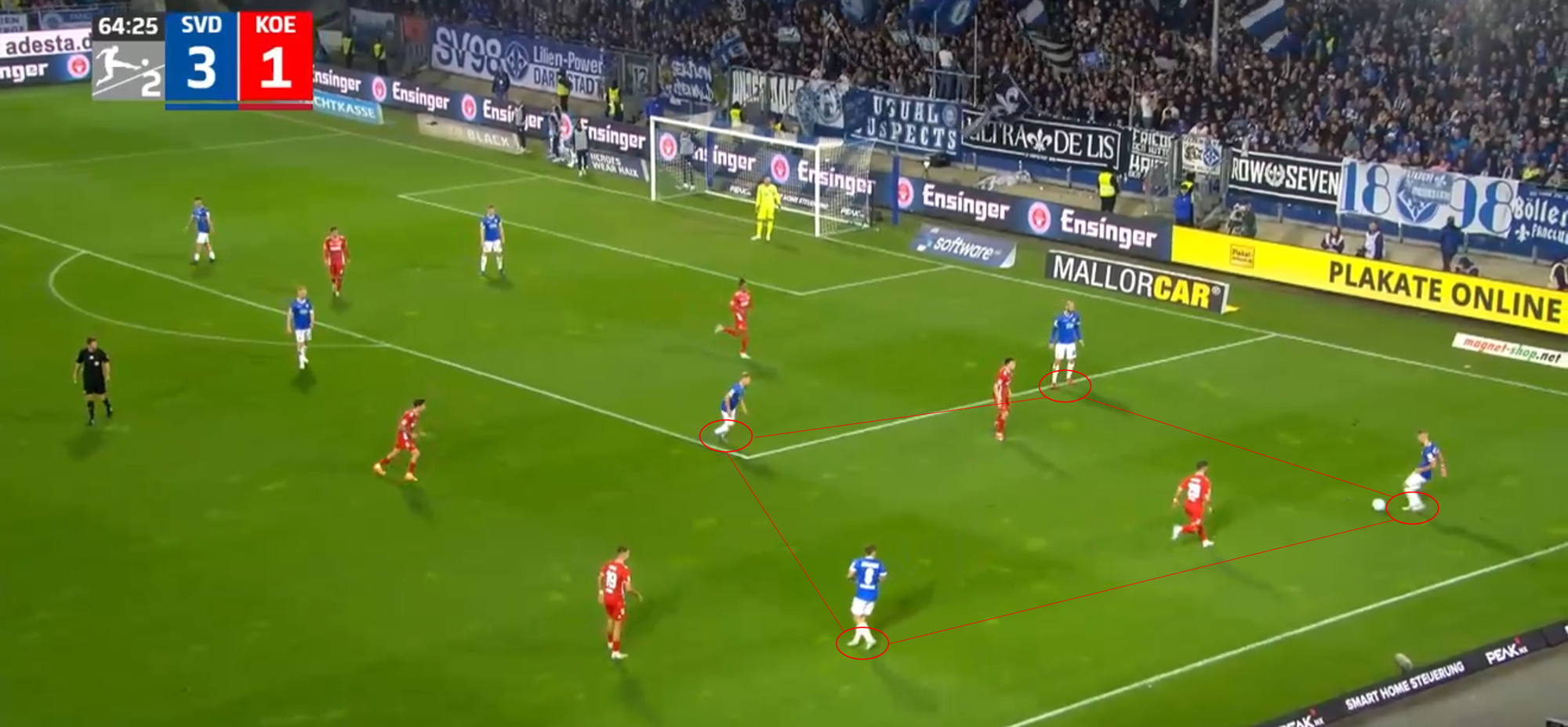
Here, we can see Darmstadt in the build-up near their own goal.
Köln is actively pressing the defensive line of Darmstadt.
Obviously, the score has some influence on that, but they were doing this for the entire game.
Under Kohfeldt, Darmstadt line up in a 4-4-2 and keeps that shape when building up on the first line of play.
We can see the back four and the two central midfielders really well.
Here, the left midfielder is also dropping back to create a diamond with the LCM, LCB, and left back.
This gives Darmstadt multiple passing options and allows them to play short passes through the pressing defenders.
Here, the centre-back plays a quick pass to the left-back, who is able to break the first line of press with a pass to the central midfielder, a great use of the third-man-principle.
This enables Darmstadt to get some playing room despite the attacking press of their opponents.
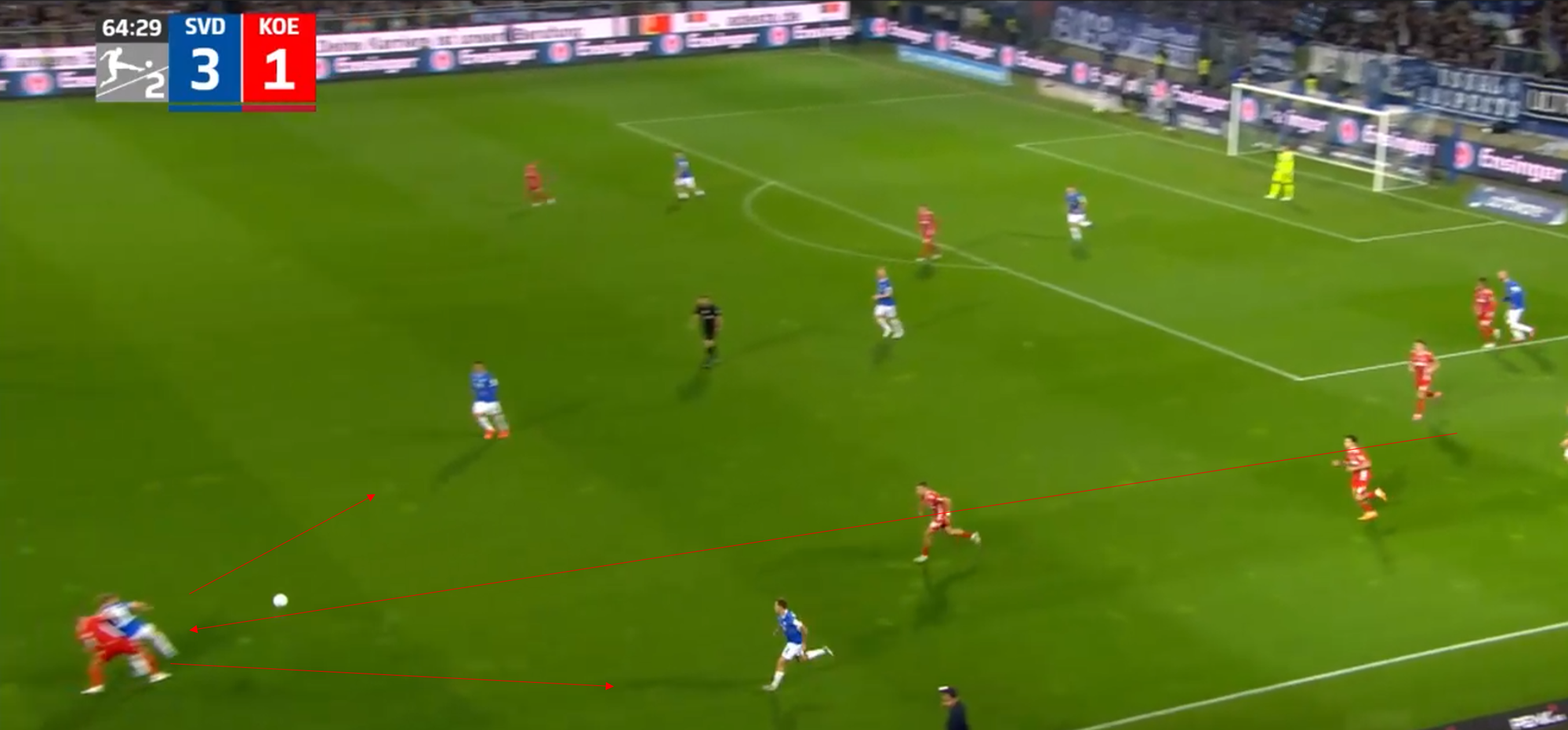
From then on, Darmstadt preferred not to play many short passes but was very vertical in its passing game.
Here, the midfielder received the ball in a half-open stance and instantly played a deep ball in the left half-space to their striker, who was dropping into midfield.
The rest of the team was moving forward into the backs of the Köln players, allowing the striker to instantly have multiple options to play a lay-off and link up with the midfield in that way.
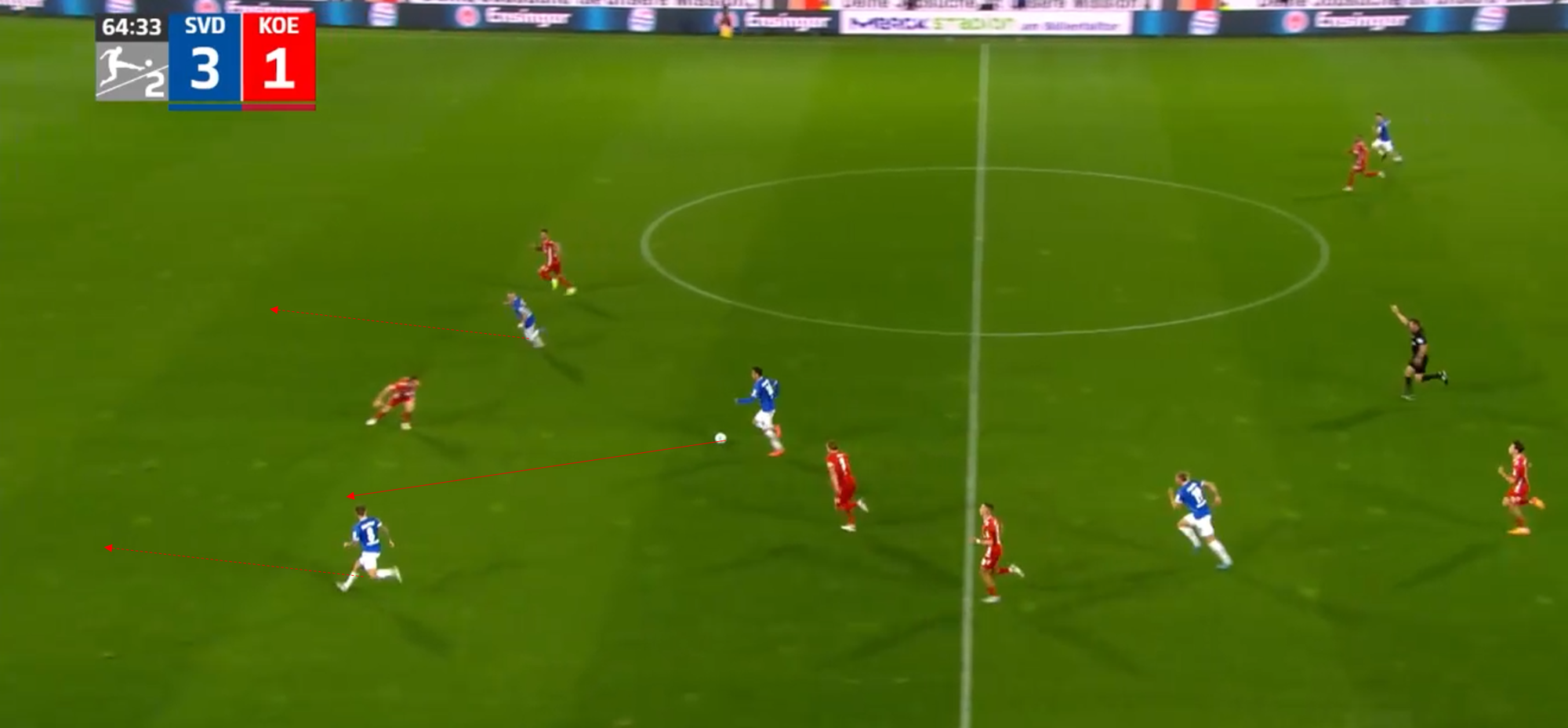
From there on, Darmstadt were able to carry the ball towards goal in a very high tempo.
Just two passes enabled them to get into a favourable situation and forced FC Köln to defend in a 2v3 situation.
Kohfeldt manages to get his men open in the space behind their opponents’ midfield, which gives his players a great positional advantage in every situation.
From then on, Darmstadt use a relatively simple principle.
They give the ball carrier one option to the left and one to the right, and both remaining attacking players in front of the ball make runs behind the defensive line.
In this situation, Förster was able to play a simple pass outwards to release his teammate into space.
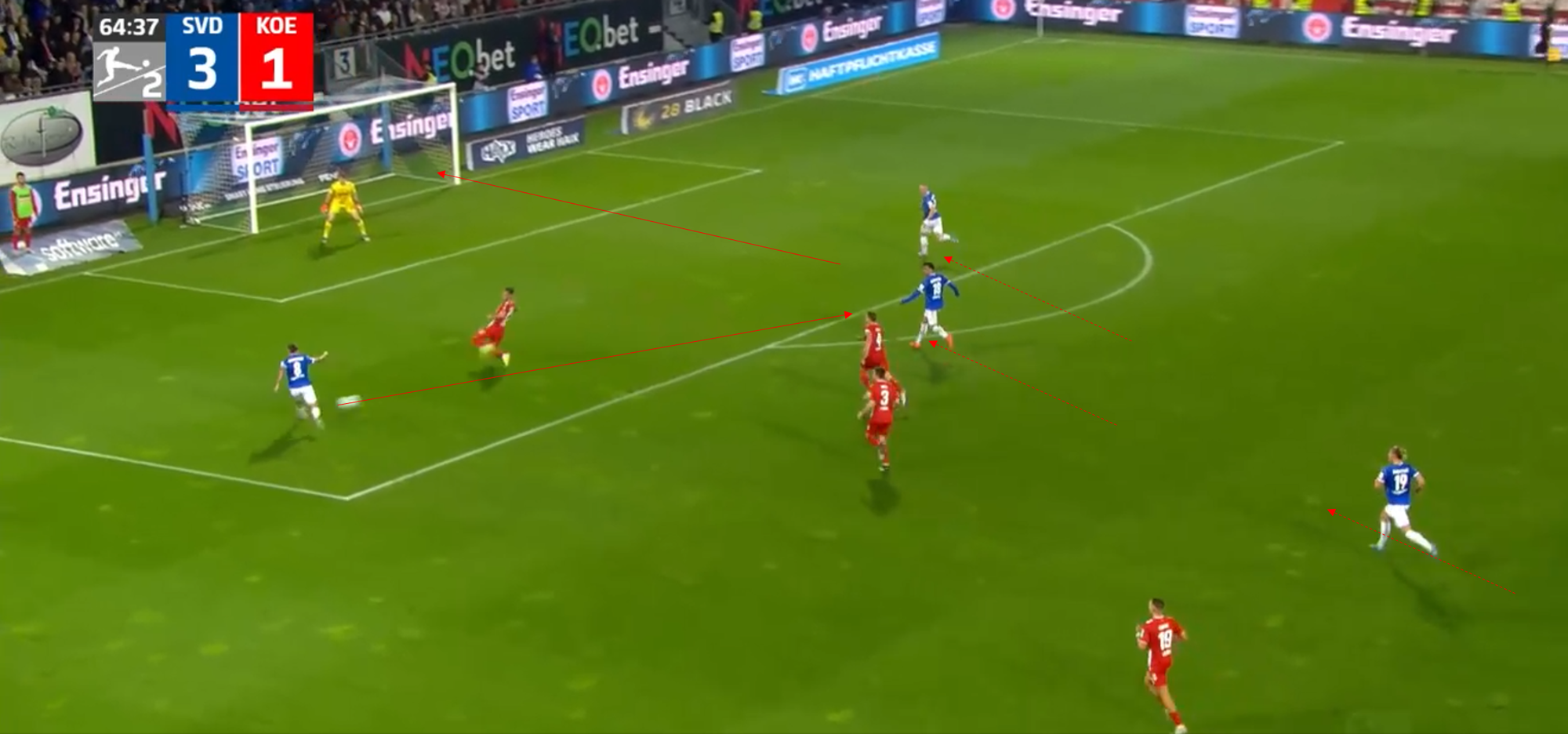
From there on, Darmstadt can finish off the attack rather easily.
All players are moving into the box at a high speed and with only one defender left, they can easily score the deciding fourth goal here against a heavily favoured Köln team.
Situations like this one showcase the newfound confidence in their attacking play.
Therefore, Darmstadt’s straightforward approach to football enables it to be one of the quickest and most threatening teams from almost every position on the field.
Darmstadt Midfield Progression
While Darmstadt is not heavily focused on their play in possession, they still needed some improvement in that regard as well.
While attacking quickly has been proven to be a very effective strategy for Darmstadt, the team has also improved its possession play under Florian Kohfeldt’s style of play.
While Darmstadt had a lot of possession in their games early in the season, they struggled immensely with ball security and creating goal-scoring opportunities out of their possession.
Under Kohfeldt, the team became much harder to predict and developed an excellent form of ball security and clear principles while they had the ball.
Let’s take a look at one of their shapes specifically now.
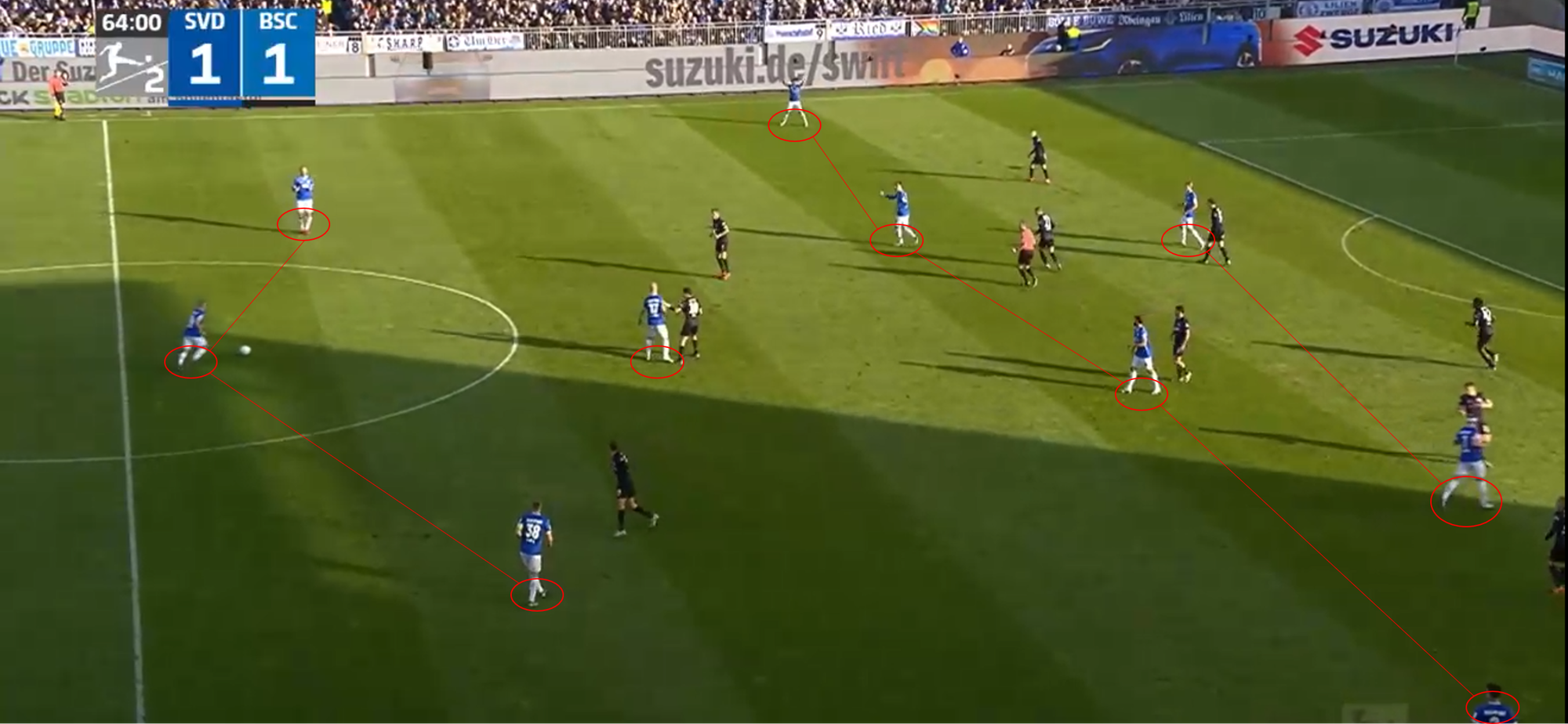
Here, we can see Darmstadt’s build-up in the second line, with their backline already in the half of their opponent.
The shape of the team changes drastically here compared to what they are usually doing.
The central midfielder Müller is dropping back into the backline, forming a back-three in this situation.
As a result, both full-backs are pushing up the field and are in very wide and high positions compared to when Darmstadt has the ball in their own half.
Both outside midfielders are pushing inwards and are now playing as midfielders in the half-spaces instead of playing on the wing.
The only thing that stays the same is the two-man attack, with both strikers lining up over a centre-back.
This creates a 3-1-4-2 shape for Kohfeldt, who does multiple things for his team.
Firstly, it stretches the field horizontally, dragging their opponents’ defensive blocks apart and allowing for switches to the wing, causing Hertha BSC‘s block to move.
Secondly, they are able to create easy numerical advantages in their first line of play, making it hard for their opponents to apply pressure to the ball without committing many men forward.
Thirdly, it overloads the centre of the pitch.
With three centre-backs, three midfielders, and two strikers, Darmstadt easily establishes control over the most crucial part of the pitch.
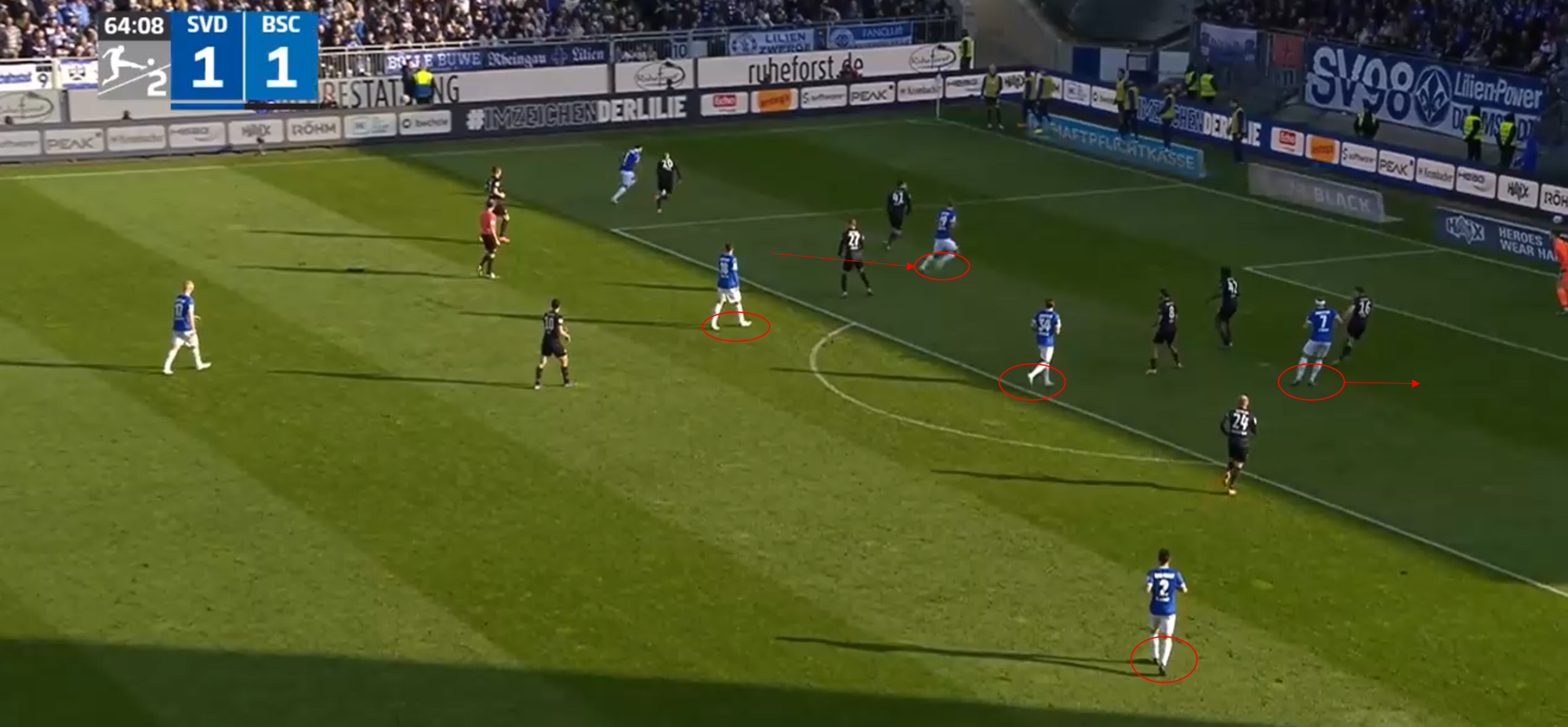
Here, Hertha’s deep block was forced to move from right to left and did not manage to make the shift in time, allowing left-back Bueno to advance into the final third.
From there on, Darmstadt has a crossing opportunity out of a very good position and has three players in the box to receive as well.
Kohfeldt does another interesting thing here: his players in the box always move against the direction of play, once again wanting his players to make runs into the backs of their defenders.
In the picture, Lidberg and Lakenmacher are moving in behind their respective defenders and finding space.
While this obviously allows the defenders to take more proactive actions for the ball, the placement of the cross traps the defenders in bad positions and allows Lidberg easy finishes.
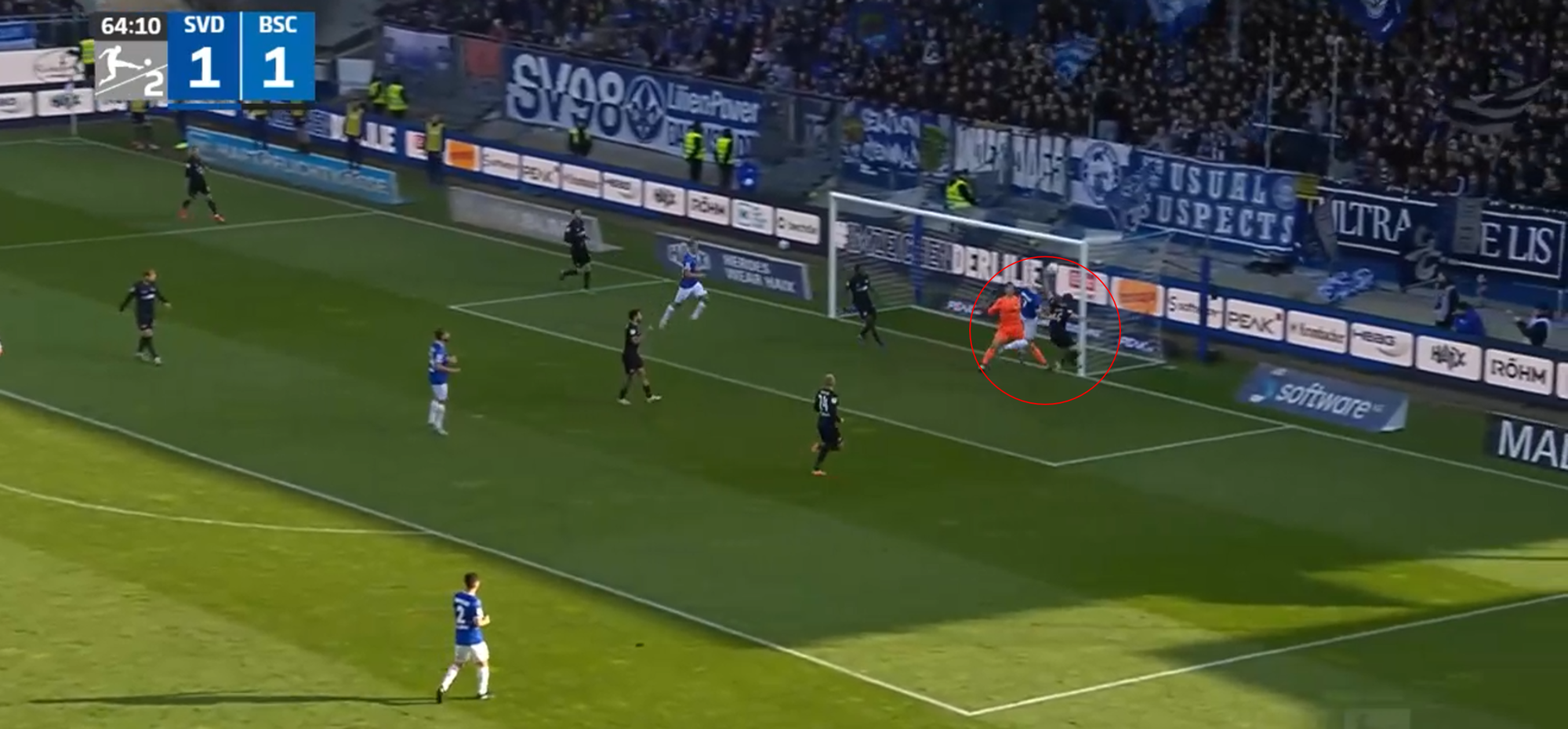
Here, the defender can’t get to the ball in the air, allowing Lidberg to get off a header to the near post.
This resulted in an easy goal and a lead for Darmstadt, which resulted in a win.
In these moments, Kohfeldt’s past as a possession-oriented coach shines through, allowing Darmstadt to make great positional play in these last couple of weeks.
Attacking As A Defensive Strategy: Tactical Analysis
As we have seen so far in this article, Darmstadt have a very attacking approach under Florian Kohfeldt’s managerial style.
Still, obviously, there are phases without the ball in the game as well.
We have already seen that Darmstadt do two things incredibly well currently.
For one, they are consistently able to find vertical passing options and try to attack in a quick manner.
Second, they are committing a lot of players forward for a presence in the centre of the field.
While the team’s vertical attacking approach has many advantages, it also has a major downside: Many of the vertical passes and crosses into the box result in losses of possession for Darmstadt.
These two factors combined make it evident that Florian Kohfeldt also had to work on their counter-pressing as a tactical measure because it meshes well with the rest of his ideas.
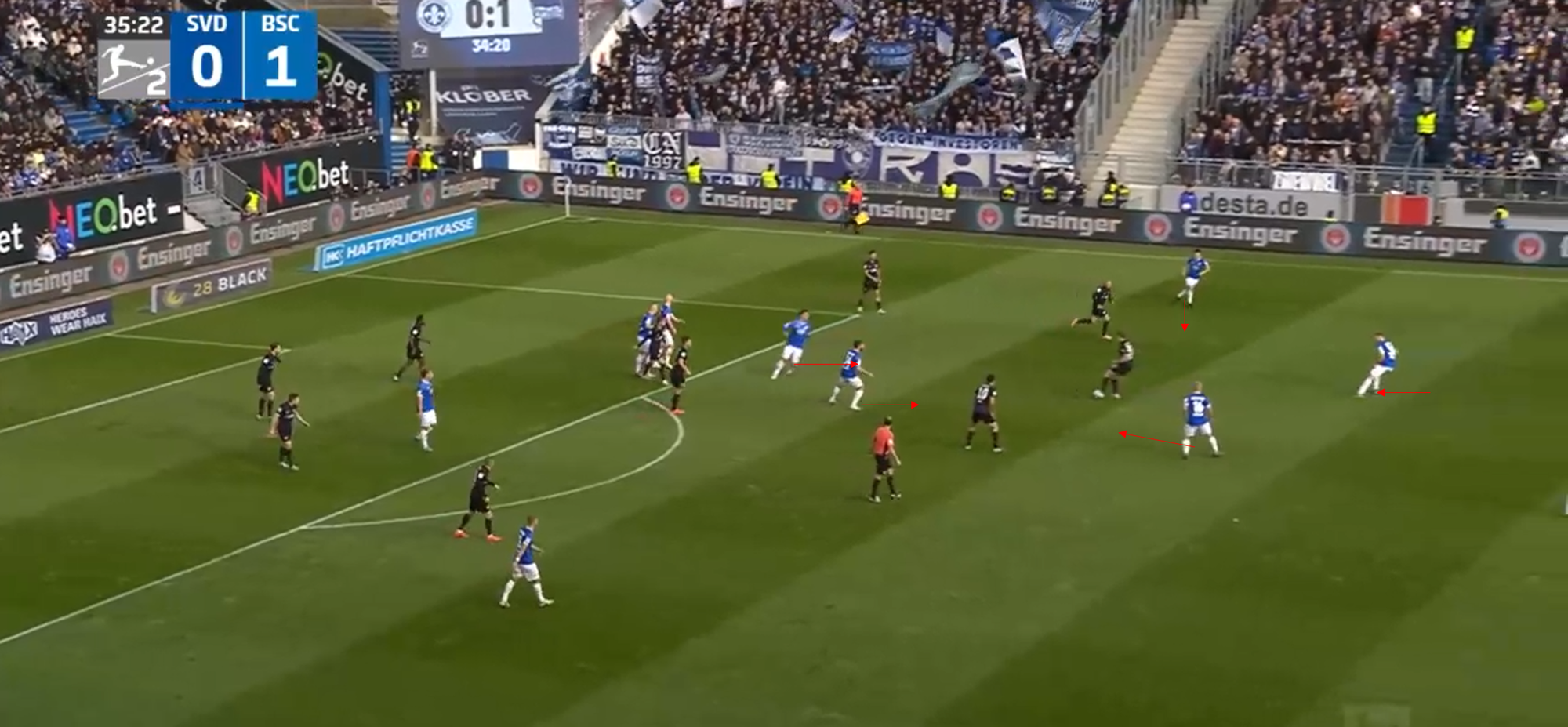
Here, we can see Darmstadt after a cross against Hertha BSC that got cleared away by a defender.
Nine Darmstadt players are already in the frame because when the crossing situation unfolded, the players were already pushing up the field and condensing the space around the box.
If the cross were unsuccessful, they would be in a position to attack the ball instantly.
The players around the ball are all closing into the Hertha player with the ball and are putting enough pressure on him so he can’t turn forward or play a forward pass.
Even the defenders are moving forward, with only one centre-back covering the depth of the pitch.
This shows that Florian Kohfeldt has managed to establish a new type of mentality in his squad.
His players trust each other and the system enough to make snapshot decisions to aggressively defend and engage in counter-pressing without a second thought.
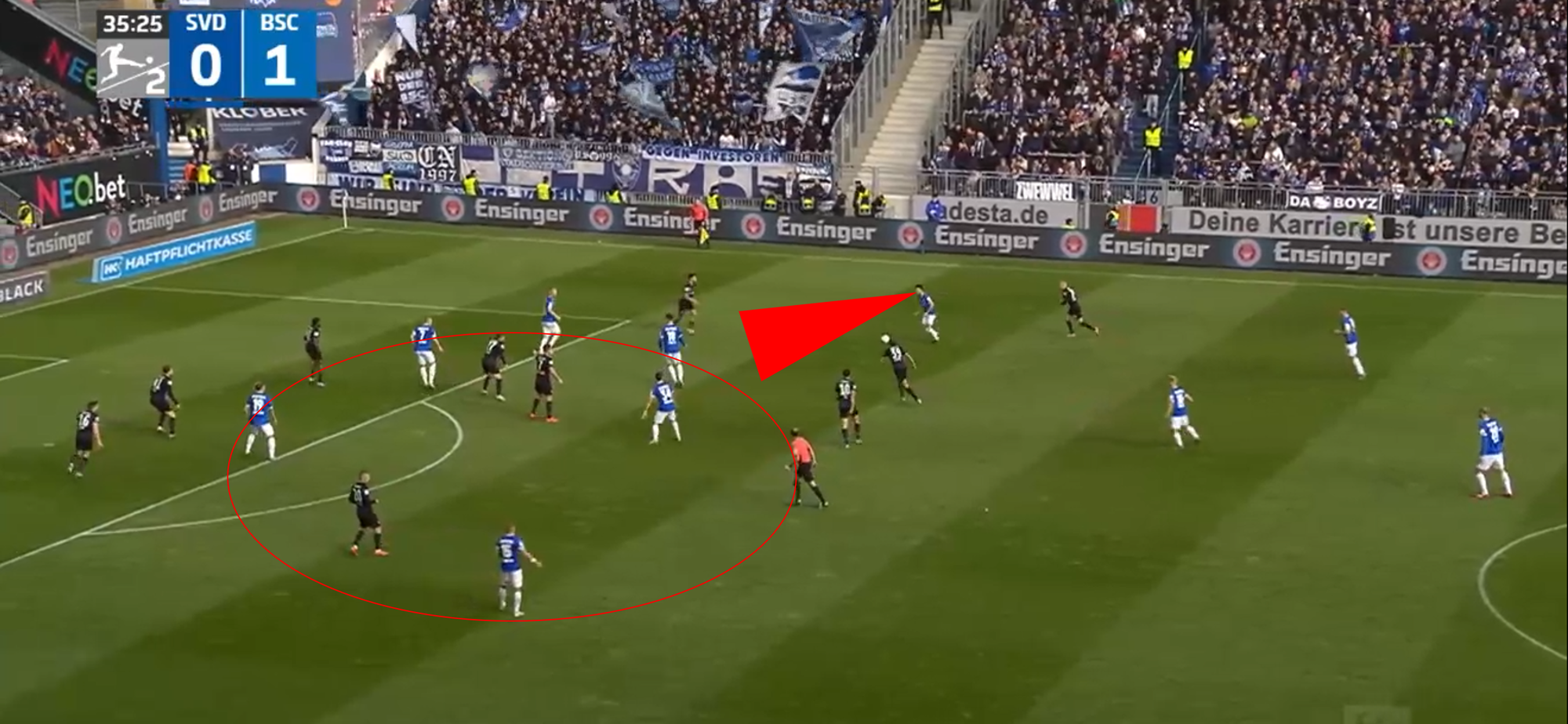
In this situation, they force a bad pass by Hertha and, after losing the ball, are able to intercept it quickly in the wing.
Once again, as we can see in the picture above, the first look after winning the ball instantly goes forward into the box, and Darmstadt is instantly in a position to attack the box once again.
This aggressive counter-press and the straightforward attacking approach are very complementary, and Darmstadt uses them well to keep the pace and pressure at a high level during their games.
Still, committing forward like that without the ball doesn’t come without risks, and Darmstadt has conceded 15 goals in the nine games under Florian Kohfeldt so far, which is still a lot.
However, considering the upside it allows them to have in attack, it is a worth trade-off currently.
Conclusion
SV Darmstadt 98 struggled a lot after their relegation in the summer, which cost their relatively long-tenured head coach Lieberknecht his job early in the season.
The hiring of Florian Kohfeldt did not spark a lot of joy or hope for the fanbase, but two months after taking over the team, things look very different right now.
Within just a couple of weeks, Kohfeldt managed to turn things around at Darmstadt and formed the struggling team into one of the best attacking teams in the league and currently looks like the most in-form team in the 2. Bundesliga.
With their straightforward and vertical attacking approach, Darmstadt scored an impressive 27 goals in the last nine games and even beat teams like 1 FC Köln and Hertha BSC, who were heavily favoured in these matchups.
Still, there are many positive things to see in possession as well, and Darmstadt managed to attack out of different settings and positions exceptionally well.
The one thing that needs more improvement is their defence.
With 15 goals conceded in 9 games, Kohfeldt has a lot of work to do here.
While his counter-pressing approach is working very well right now, it is not sustainable to score three goals a game to win, and it will be interesting to see what solutions Florian Kohfeldt comes up with this time.

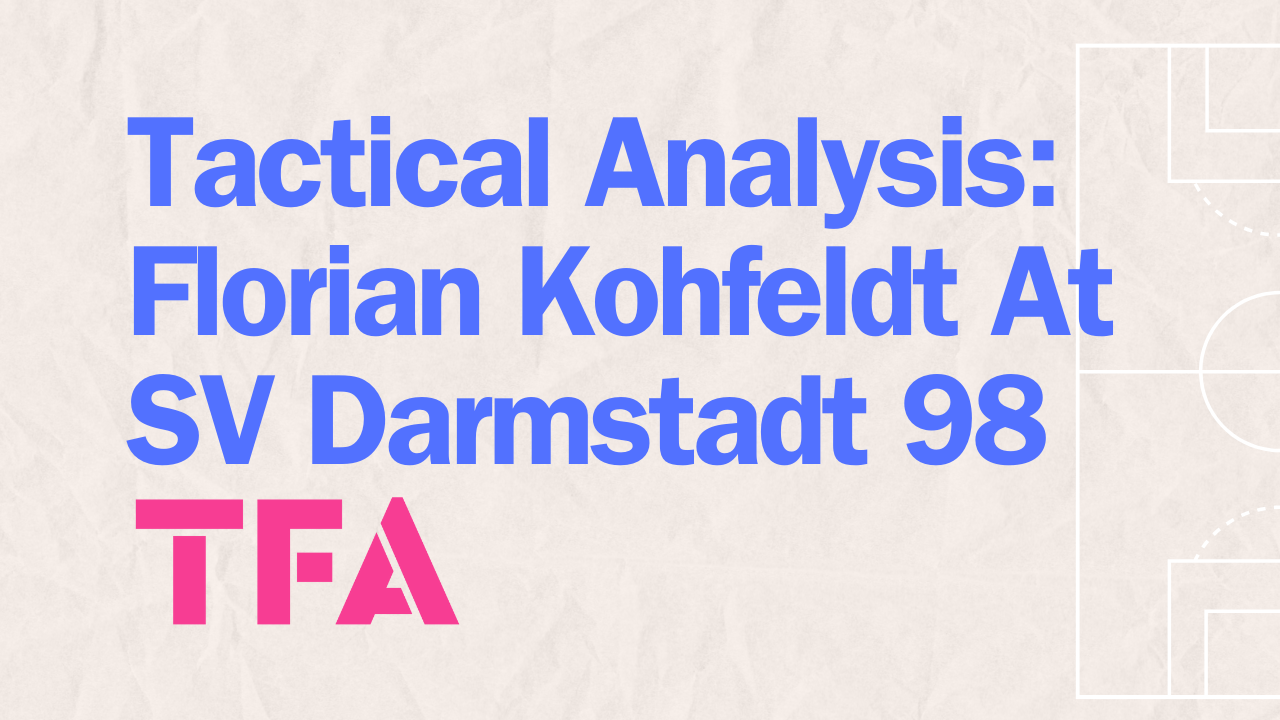




Comments